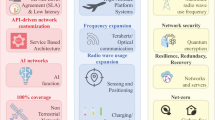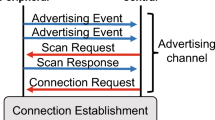Abstract
Integrating LTE sub-6 GHz and millimeter wave (mmWave) bands brings great benefit in increasing communication bandwidth, reliability, and better coverage of future smart intelligent network and its applications. However, finding the right mmWave remote radio units (RRUs) is challenging due to coverage blindness of directional beams. Further, the mmWave network depends on edge cloud deployment for satisfying low latency requirement of future smart applications. Along with, reducing energy consumption for handover execution is important due to the battery constraint of IoT (Internet of Things) device. Thus, it is important to reduce the signaling overhead of the handover process. First, this paper presents an efficient handover mechanism between LTE and mmWave; second present automatic handover execution mechanism between LTE and mmWave using a machine learning algorithm. Third presented improved XGBoost classification algorithm for predicting handover success rate using channel information collected through sampling window. Lastly, showed combining machine learning prediction model with standard handover execution model reduces signaling overhead and improves the handover success rate. The experiment is conducted by varying IoT device the result achieved shows XGBoost-based handover execution model achieves much superior performance than existing KNN-based handover execution algorithm.







Similar content being viewed by others
References
Nishimoto H, Kawahara Y, Asami T (2010) Prototype implementation of ambient RF energy harvesting wireless sensor networks. In: Proc. IEEE sensors, Nov. 2010, pp 1282–1287
Atzori L, Iera A, Morabito G (2010) The internet of things: a survey. Comput Netw 54(15):2787–2805
Poczter SL, Jankovic LM (2013) The google car: driving toward a better future? J Bus Case Stud 10(1):7–14
Hobert L, Festag A, Llatser I, Altomare L, Visintainer F, Kovacs A (2015) Enhancements of v2x communication in support of cooperative autonomous driving. IEEE Commun Mag 53(12):64–70
Chen S, Xu H, Liu D, Hu B, Wang H (2014) A vision of IoT: applications, challenges, and opportunities with china perspective. IEEE Internet Things J 1(4):349–359
Minerva R, Biru A, Rotondi D (2015) Towards a definition of the Internet of Things (IoT). IEEE Internet Initiat (Torino, Italy)
Cisco (2017) Cisco Visual Networking Index: global mobile data traffic forecast update, 2016–2021, White Paper
Iwamura M (2015) NGMN view on 5G architecture. In: IEEE 81st Vehicular Technology Conference (VTC Spring)
Boccardi F, Heath RW, Lozano A, Marzetta TL, Popovski P (2014) Five disruptive technology directions for 5G. IEEE Commun Mag 52(2):74–80
Polese M, Jana R, Kounev V, Zhang K, Deb S, Zorzi M (2019) Exploiting spatial correlation for improved prediction in 5G cellular networks. In: Information theory and applications workshop (ITA)
Rangan S, Rappaport TS, Erkip E (2014) Millimeter-wave cellular wireless networks: potentials and challenges. Proc IEEE 102(3):366–385
Chinchali S, Hu P, Chu T, Sharma M, Bansal M, Misra R, Pavone M, Sachin K (2018) Cellular network traffic scheduling with deep reinforcement learning. In: National conference on artificial intelligence (AAAI)
Li R, Zhao Z, Zhou X, Ding G, Chen Y, Wang Z, Zhang H (2017) Intelligent 5G: when cellular networks meet artificial intelligence. IEEE Wirel Commun 24(5):175–183
He Y, Yu FR, Zhao N, Yin H, Yao H, Qiu RC (2016) Big data analytics in mobile cellular networks. IEEE Access 4:1985–1996
Kubler S, Robert J, Derigent W, Voisin A, Le Traon Y (2016) A state-of the-art survey & testbed of fuzzy AHP (FAHP) applications. Expert Syst Appl 65:398–422
Ozturk M, Akram M, Hussain S, Imran MA (2019) Novel QoS-aware proactive spectrum access techniques for cognitive radio using machine learning. IEEE Access 7:70811–70827
Zhu A, Guo S, Liu B, Ma M, Yao J, Su X (2019) Adaptive Multiservice Heterogeneous Network Selection Scheme in Mobile Edge Computing. IEEE Internet Things J 6(4):6862–6875
Liu Q, Han T, Ansari N (2019) Energy-efficient on-demand resource provisioning in cloud radio access networks. IEEE Trans Green Commun Netw
Roy A, Borkar VS, Chaporkar P, Karandikar A (2019) Low complexity online radio access technology selection algorithm in LTE-WiFi HetNet. IEEE Trans Mobile Comput
Ali J, Ahmad R, Maqsood T, Rodrigues J, Haq N, Sarwar S, Iqbal T (2018) Madani S (2018) Network selection in heterogeneous access networks simultaneously satisfying user profile and QoS. Int J Commun Syst 31:e3730. https://doi.org/10.1002/dac.3730
Chen J, Wang Y, Li Y, Wang E (2018) QoE-Aware intelligent vertical handoff scheme over heterogeneous wireless access networks. IEEE Access 6:38285–38293
Liang G, Yu H (2018) Network selection algorithm for heterogeneous wireless networks based on service characteristics and user preferences. EURASIP J Wirel Commun Netw. https://doi.org/10.1186/s13638-018-1264-5
Yan L et al (2019) Machine learning-based handovers for sub-6 GHz and mmWave integrated vehicular networks. IEEE Trans Wirel Commun 18(10):4873–4885. https://doi.org/10.1109/TWC.2019.2930193
Ma B, Guo W, Zhang J (2020) A survey of online data-driven proactive 5G network optimisation using machine learning. IEEE Access 8:35606–35637. https://doi.org/10.1109/ACCESS.2020.2975004
Baccelli F, Blaszczyszyn B (2009) Stochastic geometry and wireless networks, vol I—theory. NoW Publishers
3GPP (2011) Evolved universal terrestrial radio access; LTE Positioning Protocol, 3rd Generation Partnership Project, TS 36.355
3GPP (2016) Evolved universal terrestrial radio access; radio resource control, 3rd Generation Partnership Project, TS 36.331
Sun S, MacCartney GR, Rappaport TS (2016) Millimeter-wave distance-dependent large-scale propagation measurements and path loss models for outdoor and indoor 5G systems
Author information
Authors and Affiliations
Corresponding author
Rights and permissions
About this article
Cite this article
Nayakwadi, N., Fatima, R. Automatic handover execution technique using machine learning algorithm for heterogeneous wireless networks. Int. j. inf. tecnol. 13, 1431–1439 (2021). https://doi.org/10.1007/s41870-021-00627-9
Received:
Accepted:
Published:
Issue Date:
DOI: https://doi.org/10.1007/s41870-021-00627-9




